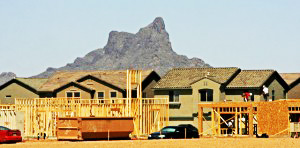 By Susan Randall | Casa Grande Dispatch
By Susan Randall | Casa Grande Dispatch
Foreclosures in Pinal County are nowhere near as common as they were a few years ago.
Arizona State University’s Center for Real Estate Theory and Practice at the W.P. Carey School of Business said monthly foreclosures in Pinal County peaked in March 2009 at 1,256.
By this February there were only 111, according to the most recent monthly housing report.
“We’ve been through a tremendous tsunami of foreclosures,” said Michael Orr, director of the center.
“Really, that supply is drying up now because those loans have all been resolved.”
Most of the delinquent loans were created between 2004 and 2008, he said.
“After all the disasters that happened in 2008 and 2009, the lenders all went to the other extreme, and instead of lending to just about anybody — because they were in a hurry to lend as much as possible — they’ve gone to the opposite extreme, starting in 2009, of only lending to people who are superbly qualified.”
That extremely tight lending policy is just starting to ease up a little now, he said, but the number of loan applications from people in their 20s and 30s and people who lost homes to a foreclosure or short sale is smaller than in the past “because they know they are going to have trouble qualifying.”
Someone who has gone through a foreclosure or short sale has to wait three, four, sometimes seven years before lenders will even consider a loan, Orr said. Meanwhile, many younger adults are not in the career they want because the economy did not take off — and they have student loans to repay.
“Even if they are motivated to apply for a loan,” he said, “they often get rejected because their debt-to-income ratio is not good enough.”
What most people call a foreclosure in Arizona is really a “trustee sale,” Orr added. If someone in Arizona goes three months without making a payment on a house, the lender will ask the trustee to sell the house.











